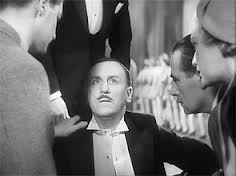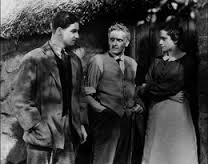For our 17th review for the Alfred Hitchcock blogathon, Zoe and I present you with a review of The 39 Steps by Niall of Raging Fluff. If you don’t already follow his blog, I strongly urge you to do so. He has some great insight on movies and is still running his Royale With Cheesathon that is all about Pulp Fiction, 20 years on.
Here’s Niall’s opinion of The 39 Steps
The 39 Steps
Summary: An innocent man is wanted for murder and drawn into a web of intrigue after foreign spies try to smuggle military secrets out of the country.
Spoilers, naturally, but really, you don’t watch a Hitchcock film for the plot (and the plot of The 39 Steps is rather silly and full of holes); rather you watch for the sheer verve with which it’s put together.
Annabella Smith: I had to get away from that theatre quickly; there were two men there who wanted to kill me.
Richard Hannay: Really, you should be more careful in choosing your gentlemen friends.
 Something odd happened to Alfred Hitchcock in America. While his Hollywood films had bigger stars and were bigger successes than his early work, there is something bloated and self-indulgent about some of them, in stark contrast to the brisk and breezy English thrillers he made for Gaumont in the 1930s. Consider, for example, the brief running time of The 39 Steps – a mere 86 minutes, and yet in that time we get a music hall revue, a murder, an exciting chase across the Scottish moors, a love story (two love stories, actually), a charming romantic comedy interlude at an inn, a rousing political speech, plenty of cheeky innuendo, another murder, and the unravelling of a mystery, all of it done with wit and style. North by Northwest – which seems like a bit of a retread – is an hour longer.
Something odd happened to Alfred Hitchcock in America. While his Hollywood films had bigger stars and were bigger successes than his early work, there is something bloated and self-indulgent about some of them, in stark contrast to the brisk and breezy English thrillers he made for Gaumont in the 1930s. Consider, for example, the brief running time of The 39 Steps – a mere 86 minutes, and yet in that time we get a music hall revue, a murder, an exciting chase across the Scottish moors, a love story (two love stories, actually), a charming romantic comedy interlude at an inn, a rousing political speech, plenty of cheeky innuendo, another murder, and the unravelling of a mystery, all of it done with wit and style. North by Northwest – which seems like a bit of a retread – is an hour longer.
 After telling our hero, Richard Hannay (Robert Donat), that she is trying to prevent a secret from being smuggled out of the country, a beautiful, mysterious woman is murdered. It has something to do with ‘the 39 Steps’. You discover at the end what the 39 Steps are, not that it really matters. After all, the joy is in the journey, not the destination. And this is a film all about the journey. It moves fast and wastes little time (except after the spy is killed and we get to see her again in an odd flashback, slowly repeating the information we just heard a few minutes before: did Hitch not trust the audience to keep up?)
After telling our hero, Richard Hannay (Robert Donat), that she is trying to prevent a secret from being smuggled out of the country, a beautiful, mysterious woman is murdered. It has something to do with ‘the 39 Steps’. You discover at the end what the 39 Steps are, not that it really matters. After all, the joy is in the journey, not the destination. And this is a film all about the journey. It moves fast and wastes little time (except after the spy is killed and we get to see her again in an odd flashback, slowly repeating the information we just heard a few minutes before: did Hitch not trust the audience to keep up?)
 As with most of Hitch’s MacGuffins, if you examine it too closely, it falls apart: if the matter is so urgent, why does she insist on getting a good night’s sleep in Hannay’s flat? And why do the bad guys kill her but leave him alive? And – as with many of Hitchcock’s films – why can nobody trust Scotland Yard? The answer to the last question probably lies with Hitchcock’s lifelong fear of the police: after some trifling matter when he was a child, his father had the local bobby lock him in a cell.
As with most of Hitch’s MacGuffins, if you examine it too closely, it falls apart: if the matter is so urgent, why does she insist on getting a good night’s sleep in Hannay’s flat? And why do the bad guys kill her but leave him alive? And – as with many of Hitchcock’s films – why can nobody trust Scotland Yard? The answer to the last question probably lies with Hitchcock’s lifelong fear of the police: after some trifling matter when he was a child, his father had the local bobby lock him in a cell.
 In any event, Hannay finds himself on the Highland Express, allowing the director to show off his dark sense of humour: the scream of the train-whistle is timed to the scream of a woman; a pair of corset salesmen have an innuendo-filled conversation and scandalise a curate; a meet-cute in a compartment is interrupted by the police; a waiter laden with a tray sidesteps a carriage-load of coppers; and there’s plenty of stage-Scottishness from the local constabulary and the irate engineer. When a paper-boy calls out ‘Peeper!’, one of the salesman asks him ‘Speaka da English?’
In any event, Hannay finds himself on the Highland Express, allowing the director to show off his dark sense of humour: the scream of the train-whistle is timed to the scream of a woman; a pair of corset salesmen have an innuendo-filled conversation and scandalise a curate; a meet-cute in a compartment is interrupted by the police; a waiter laden with a tray sidesteps a carriage-load of coppers; and there’s plenty of stage-Scottishness from the local constabulary and the irate engineer. When a paper-boy calls out ‘Peeper!’, one of the salesman asks him ‘Speaka da English?’
The Scotch mist is heavy throughout the entire Highlands: people in the hoose are afeared or they ken something. A glum, penny-pinching, Bible-thumping crofter is played by that most dour of Scotsmen, grizzled John Laurie (who looked ancient even in 1935, 40 years before Dad’s Army)
 Hannay: Could you put me up for the night somehow?
Hannay: Could you put me up for the night somehow?
Crofter (warily): Free?
Hannay: No, I’ll pay.
Crofter: Can you eat the herring?
Hannay: I could eat half a dozen right now.
Crofter: Can you sleep in a box bed?
Hannay: I can try.
Crofter (quickly): Two and six.
The crofter’s beautiful and much younger wife is Peggy Ashcroft, a Glasgow girl stuck in the country and pining for the bright lights of the city. She pines, too, for Hannay, helping him escape, and for a brief second you think she’ll become the love-interest.
Of course she helps him: it’s Robert Donat, after all, at perhaps his most charming and witty as the quintessential Hitchcockian wrong man. For a man in peril, he seems to rather enjoy the chase – especially when he gets manacled to Pamela (Madeleine Carroll) – and he has a good amount of one-liners:
A flock of sheep blocks the “police car”
Hannay: Oh, look, it’s a whole flock of detectives.
After being handcuffed to Pamela
Pamela: You can’t possibly escape. What chance have you got tied to me?
Hannay: Keep that question for your husband.
They spend the last third of the film handcuffed together trading insults, a sure sign of love (the film’s final shot is of their hands entwined.) They spend the night at an inn posing as a runaway couple, and she must remove her wet stockings and try to keep his hand off her legs. The 39 Steps is a rather sexy film.
When Hannay comes face-to-face with the villain, the Professor (Godfrey Tearle), they have a very chummy and civilised conversation over drinks (similar to the encounter that Cary Grant and James Mason have in North by Northwest.)
Professor: I’m sorry, Mr Hannay, I’m afraid I’ve been guilty of leading you down the garden path. Or should it be up? I never can remember.
Hannay: It seems to be the wrong garden, all right.
 As with much of Hitchcock, you have to accept some things without question. For instance, you have to accept that Hannay is Canadian even though he sounds as if he has lived in Knightsbridge his whole life. He claims not to be a member of the idle rich, yet he can afford to rent a furnished flat in a posh part of London for several months while doing probably nothing. (In John Buchan’s novel, Hannay has just returned to London having made a pile of money mining in South Africa). Certainly it’s his demeanour, his gait, his voice, his very Englishness that wins over the audience at a political rally, where he gives a rousing speech filled with the sort of local colour that canny politicians always throw in to schmooze the crowd (“that magnificent structure, the Forth Bridge, that monument to Scottish engineering and Scottish muscle”).
As with much of Hitchcock, you have to accept some things without question. For instance, you have to accept that Hannay is Canadian even though he sounds as if he has lived in Knightsbridge his whole life. He claims not to be a member of the idle rich, yet he can afford to rent a furnished flat in a posh part of London for several months while doing probably nothing. (In John Buchan’s novel, Hannay has just returned to London having made a pile of money mining in South Africa). Certainly it’s his demeanour, his gait, his voice, his very Englishness that wins over the audience at a political rally, where he gives a rousing speech filled with the sort of local colour that canny politicians always throw in to schmooze the crowd (“that magnificent structure, the Forth Bridge, that monument to Scottish engineering and Scottish muscle”).
The speech is marked by a very Thirties sort of leftism (the Left was very much in vogue then) : “a world where everybody gets a square deal and a sporting chance, a world from which suspicion and cruelty and fear have been forever banished.” The foreign power that wants to steal the secrets is not named, just as it wasn’t named in The Man Who Knew Too Much, but I think it’s safe to assume it’s probably not Fascist Germany (still regarded quite well in 1935 by practically everyone except Churchill), nor is it Stalinist Russia (lauded by British intellectuals at the time).
The 39 Steps contains many familiar Hitchcock touches: an innocent man on the run; a beautiful, cool blond; a charming villain; doubtful police; sinister heavies; sexy repartee; and a nuanced understanding of the subtleties of class difference. The director makes his cameo early in the film (outside the music hall.)
Verdict: Four-and-a-half MacGuffins out of Five








Pingback: What are “The Thirty-Nine Steps”? | silence cunning exile ... maple syrup
thx for posting, rob
LikeLike
Hey Niall.
Just wanted to let you know that I scheduled a few of your genre grandeur posts over the next week. First one is in about 7 hours from now. Tnx again
LikeLike
cheers, rob. I had hoped to send you a couple more, but I haven’t been able to rewatch as many war flicks as I planned, mainly because I got sucked into a few TV series and went on a binge. If you haven’t seen the UK drama “Utopia”, go watch it.
LikeLike
One of his very best; I love this film. Fine work.
LikeLike
ditto. cheers
LikeLike
One of the Hitchcock films I’m a bit ashamed I’ve not seen…
LikeLike
oh it’s lots of fun
LikeLike
Pingback: Alfred Hitchcock Blogathon Conclusion | The Sporadic Chronicles of a Beginner Blogger
Pingback: Alfred Hitchcock Blogathon Recap |
Question, I studied Hitchcock in my college days and raised in Levittown Pa. In a Hitchcock film that I don’t know the title of the background of the closing credits are the ” Morrisiville Free Bridge” over the Delaware river. As the film ended myself and other students all were shocked. If you know this film could you please reply, thanks Pat B.
LikeLiked by 1 person